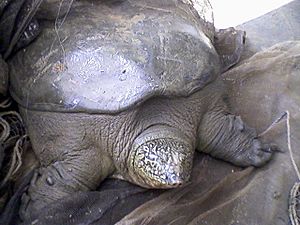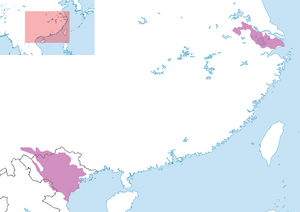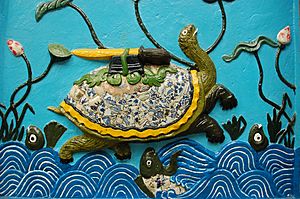Yangtze giant softshell turtle facts for kids
Quick facts for kids Yangtze giant softshell turtle |
|
|---|---|
 |
|
| One of the two R. swinhoei of Dong Mo, Son Tay, Vietnam | |
| Conservation status | |
| Scientific classification | |
| Genus: |
Rafetus
|
| Species: |
swinhoei
|
 |
|
| Yangtze giant softshell turtle range | |
| Synonyms | |
|
|
The Yangtze giant softshell turtle (Rafetus swinhoei) is a very rare species of turtle. People also call it the Red River giant softshell turtle or the Shanghai softshell turtle. It might be the biggest freshwater turtle alive today. This turtle lives in eastern and southern China and northern Vietnam. Sadly, there are only a few known individuals left. Because of this, scientists consider the species to be functionally extinct. This means it's unlikely to recover on its own.
Contents
Discover the Yangtze Giant Softshell Turtle
The Yangtze giant softshell turtle has a unique look. It has a deep head with a snout that looks like a pig's nose. Its eyes are on top of its head. This turtle is the largest freshwater turtle in the world. It is even bigger than alligator snapping turtles.
Size and Weight of the Giant Turtle
These turtles can grow very large. They can be over 100 cm (39 in) (about 3.3 feet) long. Their width can reach 70 cm (28 in) (about 2.3 feet). They can easily weigh up to 70–100 kg (150–220 lb) (150-220 pounds). Some very large ones, especially in Vietnam, might have weighed up to 247.5 kg (546 lb) (545 pounds).
The turtle's shell, called a carapace, can be larger than 50 cm (20 in) (20 inches). The biggest shell found was 86 cm (34 in) (34 inches) long. Some reports say shells can be up to 106 cm (42 in) (42 inches) along their curve. The turtle's head can be over 20 cm (7.9 in) (8 inches) long. Male turtles are usually smaller than females. They also have a longer, larger tail.
Where Do These Turtles Live?
The Yangtze giant softshell turtle used to live in the Yangtze River and Lake Tai in eastern China. It also lived in parts of Yunnan Province in southern China. These areas include Gejiu, Yuanyang, Jianshui, and Honghe.
Known Locations and Sightings
- A turtle at the Beijing Zoo died in 2005. Another at the Shanghai Zoo died in 2006. Both were caught in Gejiu in the 1970s.
- In Vietnam, turtles were seen in Hoan Kiem Lake in Hanoi. One turtle was captured in 2011 for medical treatment. It had open sores from pollution or injuries. This turtle sadly died in January 2016.
- On April 13, 2019, the only female turtle at Suzhou Zoo in China died. This happened after an attempt to help her lay eggs.
- In 2020, a wild female turtle was found in Dong Mo Lake, Vietnam. Another turtle is thought to live there too.
- The Dong Mo female turtle died in April 2023. This leaves only two known turtles. One is at Suzhou Zoo. The other is believed to be in Xuan Khanh Lake, Vietnam.
Life and Habits of the Yangtze Giant Softshell Turtle
These turtles are very shy. Despite their huge size, they rarely come to the surface to breathe. They prefer to stay hidden deep underwater. This makes them very hard to find and confirm in the wild.
Diet of the Giant Turtle
R. swinhoei eats many different things. Their diet includes:
- fish
- crabs
- snails
- water hyacinth (a plant)
- frogs
- "green rice leaves"
Reproduction and Life Cycle
Female Yangtze giant softshell turtles can lay many eggs. They may lay from 20 to more than 80 eggs at a time. They usually build their nests at night or in the morning.
Conservationists tried to help these turtles reproduce. In 2008, a female from Changsha Zoo was moved to Suzhou Zoo. She was paired with the only known male in China. He was about 100 years old. In 2013, the pair laid 80 eggs, but none were fertile. This means they could not hatch. Scientists tried to improve their diet with calcium. They hoped this would make the eggs stronger.
In 2009, the zoo announced that 188 eggs were laid, but they were still infertile. Trash thrown into the enclosure by visitors might have harmed the turtles' health. In 2010, the female laid 63 more eggs. Again, they were infertile. In 2015, scientists tried artificial insemination. This was a first for this species. The female laid 89 eggs, but none were viable. She died in April 2019 after another artificial insemination attempt.
Protecting the Yangtze Giant Softshell Turtle
This turtle is very close to disappearing forever. Its biggest threats are:
- Losing its natural home (habitat loss).
- Being hunted for food and traditional medicine.
- Illegal wildlife trade.
- Skulls are sometimes kept as trophies.
- New dams being built could flood their remaining homes.
Conservation Efforts to Save the Species
People are working hard to save these turtles.
- Captive Breeding: Efforts focus on breeding turtles in zoos. The female from Changsha Zoo was moved to Suzhou Zoo to breed with the male there.
- Improving Conditions: Zoos are trying to make better homes for the turtles. They want to help them breed successfully.
- Searching for Wild Turtles: Scientists are looking for more turtles in the wild. They are checking remote parts of China and Vietnam. Locals have reported seeing large turtles in the Red River area. This gives hope that more might exist. DNA from lake water is also used to find them.
Rediscovered Individuals
- In April 2018, a second wild turtle was confirmed in Xuan Khanh Lake, Vietnam. DNA from the lake water helped confirm it was an R. swinhoei.
- In November 2018, a second, smaller turtle was found in Dong Mo Lake. Both turtles were seen at the same time.
- In 2020, the Dong Mo turtle was caught for genetic samples. It was a female, the first known female since 2019. Sadly, this female died in early 2023.
Other sightings have been reported but not confirmed. Fishermen in China have seen large softshell turtles. A conservation group also found a pond in Laos where a turtle lived for 45 years. It moved to a river during a storm and was not seen again.
The Legend of Kim Qui
The turtle in Hoan Kiem Lake in Hanoi is part of a famous Vietnamese legend. People believe it is the legendary Kim Qui, or Golden Turtle God. This golden turtle is said to appear at important times in Vietnamese history.
Kim Qui and the Magical Sword
- King An Dương Vương: The Golden Turtle first appeared long ago. It helped King An Dương Vương build defenses for his capital city, Co Loa. When Co Loa was attacked, Kim Qui helped the king make a magical crossbow. This crossbow could shoot many arrows at once. Kim Qui also warned the king when his daughter betrayed him.
- Emperor Lê Lợi: In the 15th century, a leader named Lê Lợi found a magical sword called Heaven's Will. He used this sword to fight against the Chinese armies occupying Vietnam. After winning and becoming emperor, Lê Lợi returned to the lake. Kim Qui appeared and asked for the sword back. The King threw the sword to Kim Qui. The turtle caught it with its teeth and then disappeared into the water. Lê Lợi then named the lake 'Lake of Returning Sword', or Hoan Kiem.
Images for kids
See also
 In Spanish: Tortuga de Swinhoe para niños
In Spanish: Tortuga de Swinhoe para niños




